|
by Heng Chye Kiang, Malone-Lee Lai Choo and Zhang Ji
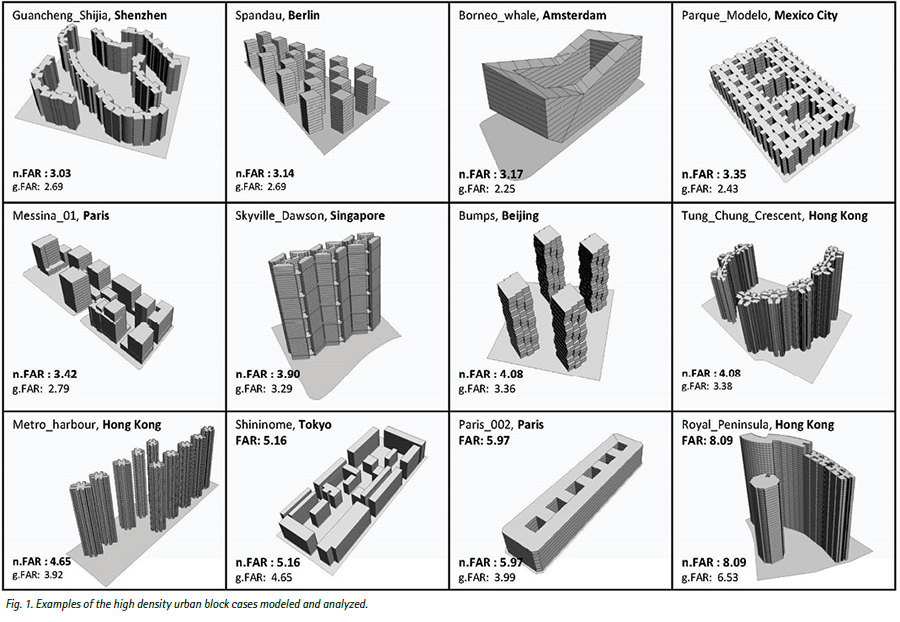
Abstract
The outcome of a comprehensive case study of contemporary urban forms indicates that urban density and urban and architectural design strategies matter to a great extent in pursing sustainable cities with good environmental performance in a variety of areas. The methodology and technology as developed provide reliable and efficient support for informed decision-making in urban planning exploration and policy making.
Introduction
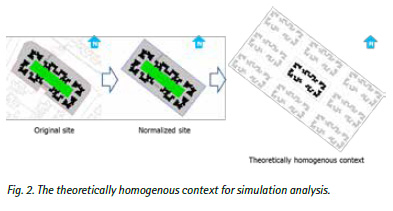 Cities stand at the frontline in the global sustainability agenda. Various perspectives and approaches have been adopted in the investigation of the relationship between urban sustainability and urban density. In the context of the cities in Asia and other developing regions, high density urban development has seemed to be an inevitable strategy to cope with the mounting challenges of an ever-growing urban population, fast urbanization rate and limited buildable land resources. For example, the city state of Singapore is renowned for its large scale public housing development that provides accommodation for more than 80% of its residential population within satellite new towns. As a result of the continued growth of the urban population and very limited land area, high-density development will continue to be one of the primary approaches to achieve the house planning objectives. There is a need to better understand the implications of high density development, specifically in environmental quality, and explore research methodologies to support innovative planning and design of high density development that do not compromise environmental performance.
Cities stand at the frontline in the global sustainability agenda. Various perspectives and approaches have been adopted in the investigation of the relationship between urban sustainability and urban density. In the context of the cities in Asia and other developing regions, high density urban development has seemed to be an inevitable strategy to cope with the mounting challenges of an ever-growing urban population, fast urbanization rate and limited buildable land resources. For example, the city state of Singapore is renowned for its large scale public housing development that provides accommodation for more than 80% of its residential population within satellite new towns. As a result of the continued growth of the urban population and very limited land area, high-density development will continue to be one of the primary approaches to achieve the house planning objectives. There is a need to better understand the implications of high density development, specifically in environmental quality, and explore research methodologies to support innovative planning and design of high density development that do not compromise environmental performance.
Methodological Approaches
A case study approach was adopted for this research project, and representative urban street blocks or precincts were selected from various cities in different social and climatic contexts that capture variety in terms of built density, building geometric characteristics, and design strategies in contemporary practices (Figure 1). The primary objectives are to understand the typological diversity of existing urban forms, examine the current planning and design approaches that achieve relatively high density and accumulate adequate quantitative information to investigate the relationship between density, urban form and environmental performance. In the final compilation, more than 90 urban form cases with an average Floor Area Ratio (FAR) of 3.35 were identified, modeled and analyzed. A database was established which records the key planning, design and performance information of each urban block case.
A unique research approach adopted was one in which the urban block under study was isolated from its existing context, and a normalization process was applied to transform the site into a 3x3 grid layout with the spacing between each site being the widths of the existing roads surrounding the original site (Figure 2). Using this approach, the environmental impacts of a particular urban block on its immediate context, such as shadow casting, radiation reflection and view obstruction, are "mirrored" back to its own site and added upon itself, ironing out the uneven influences of the irregular surroundings that may occur in reality. It is within this homogenous physical context that the "theoretical" performance of a particular environmental parameter for a given urban form was evaluated.
Regarding the rationale for performance indicator, it is argued that, from a first-principle point of view, the environmental quantity as aggregated over building surfaces needs to be normalized by total usable floor areas, which are usually directly indicative of the amount of usable spaces or number of occupants that might be affected eventually, so as to address the environmental potential as shared or accessible for each unit of floor space (Zhang, 2013; Zhang, Heng, Malone-Lee, Hii, et al., 2012; Zhang, Heng, Malone-Lee, Huang, et al., 2012). The utility of the indicator derived according to the above rationale lies in its effectiveness in differentiating the environmental performance potential of urban geometries in different forms and densities, especially for meso-scale urban analysis, regardless of the details of architectural design to be developed in a later stage.
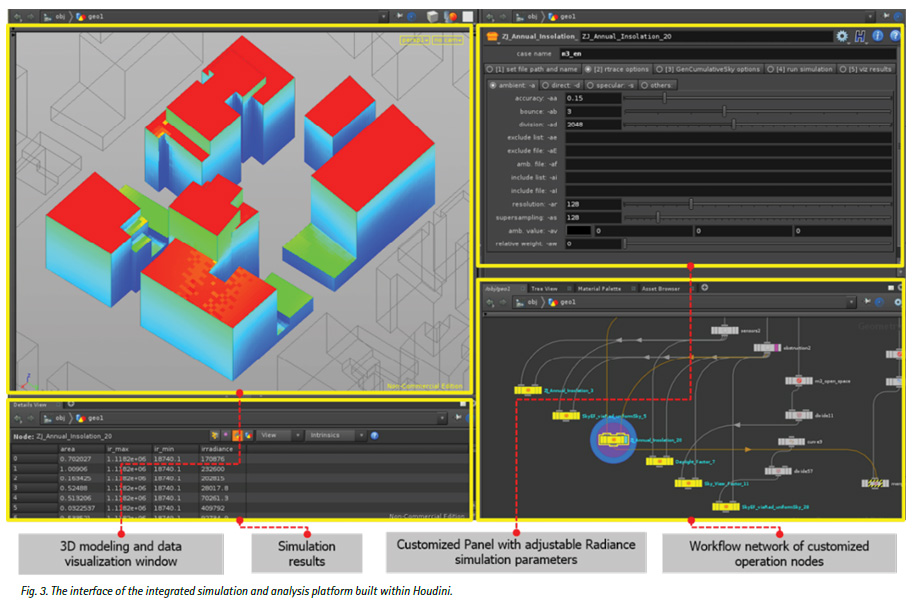
Several key environmental parameters were identified for this study, each of them having different direct or indirect implications in people's physiological comfort and psychological well-being, building energy consumption, Urban Heat Island effect, and air pollutant dispersion, such as daylight availability, solar radiation incident, level of exposure to the sky and outdoor wind movement. A series of geometric variables were calculated for each urban block case that address its formal traits from different perspectives so as to examine the relationship between urban form and environmental performance as geometric characteristics represent the design factors that can be tested and adjusted by planners and architects during early stage of design to improve performance using different design strategies. A workflow was established by combining different software tools to streamline the simulation and analysis of the urban block cases systematically and efficiently (Figure 3).
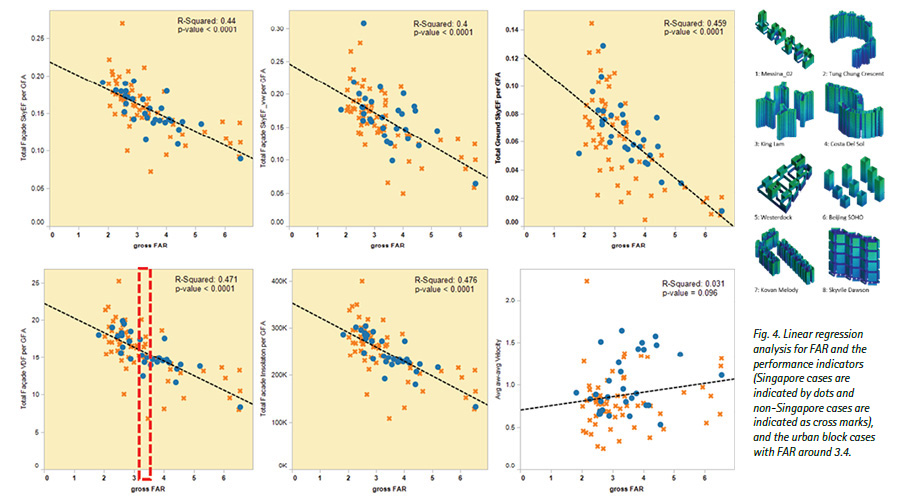
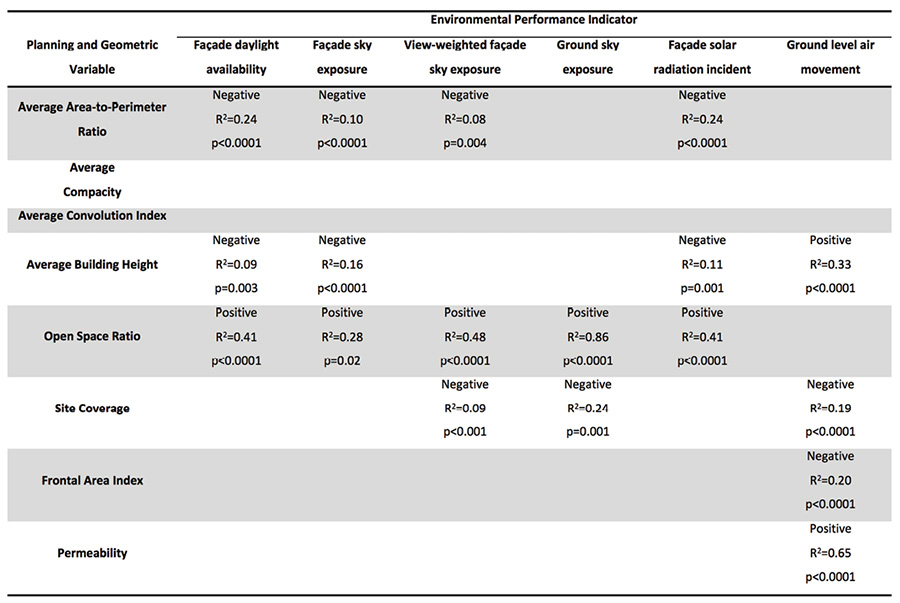
The Relationship between Density, Urban Form and Environmental Performance
In order to understand the impact of density on environmental performance, linear regression analysis was conducted for the urban block cases studied using gross FAR1 as the independent variable and the performance indicators for daylight, solar radiation, sky exposure and wind flow as the dependent variables. The results are shown in Figure 4.
It was found that FAR is significantly and negatively related to all the performance indicators except for that of ground level air movement. This suggests that, depending on planning and design strategies implemented, as density increases, it is very likely that the environmental performance of an urban design in terms of facade sky exposure, view-weighted facade sky exposure, ground sky exposure, and daylight may drop significantly.
Another prominent observation is the wide range of performance across the cases studied. For example, the lower left chart in Figure 4 shows the relationship between density and façade daylight performance. For illustrative purpose, the urban block cases within the FAR band of 3.4 are shown to the right of the chart. The diversity in geometric characteristics and spatial composition of buildings, and the wide range of facade daylight performance in these cases demonstrate the variety in and the contrast between planning and design strategies applicable to achieve the same density but resulting in vastly different environmental performance.
To investigate how the environmental parameters examined might be affected by different design factors, linear regression analysis was also conducted pairwise between the planning and geometric variables identified and the environmental performance indicators proposed. The statistically significant results are summarized in Table 1.
Among the planning and geometric variables examined, Open Space Ratio stands out as the most prominent design factor in that it is significantly related to five of the six performance indicators and its impact is the strongest as compared to that of the other factors. On the other hand, Compacity and Average Convolution Index does not seem to have any significant influence on any of the environmental parameters for the cases studied.
Applications
Several areas of application in research and design practice can potentially benefit from the framework, methodology and technology developed by this study.

Firstly, the urban form database can be used as a source of design reference for urban planners and architects, utilizing the design information collected. Secondly, the theoretical performance regarding a particular environmental parameter across different urban form cases can be extracted and compared by referring to the respective performance indicator as calculated and documented in the database. Thirdly, the planning and geometric variables examined in this study, and possibly additional ones to be investigated in the future, are design factors that can potentially inform planners and architects of new design approaches to improve the environmental performance in one or several areas. Lastly, the simulation workflow and toolsets developed in this study can facilitate the performance optimization oriented design exploration for theoretical investigation involving hypothetical generic urban forms, and they can also be applied in a realistic urban context. This is illustrated in the example shown in Figure 5.
The two different urban block typologies shown above were proposed for the same site within a particular urban texture, one in the form of enclosed courtyard perimeter block and the other a hybrid of high-rise towers and mid-rise podiums. Although both designs have similar density, their environmental performances differ greatly: the courtyard typology has 39% lower façade solar radiation incident, but the hybrid typology has 65% higher façade daylight access, 64% higher façade sky exposure and 25% higher ground sky exposure. Based on these results, planners and designers can decide on the design to be selected for further development according to planning objectives and design strategies that can be implemented to improve the performance in a certain area.
Conclusion
The findings from this study confirm the significant relationship between urban density and environmental performance. Most of the environmental parameters examined were significantly affected as density changes. This suggests that, in strategizing development density, planners and decision-makers need to be aware of its significant implications in environmental potential and the associated impacts on environmental quality in a variety of performance areas. The difference in intensity and propensity of the impact of density on different performance domains stresses the need for coordinated planning strategies that balance different performances. This study also provides concrete evidences that confirm the significant relationship between urban form and environmental performance through extensive examination of real urban block cases from diverse backgrounds. The significant impacts of the key planning and geometric variables on the proposed performance indicators as revealed emphasize the necessity and importance of exploring different design strategies and their combinations aiming to improve environmental performance, especially at the meso-scale of urban analysis.
In addition, the key concepts developed in the study and the integrated workflow and simulation toolset created can be instrumental to facilitate researchers and designers in conducting efficient and reliable performance optimization oriented design exploration. Nonetheless, the challenges in deriving optimal design solutions for a given density lie in the careful selection and prioritization of the environmental parameters relevant to the local climatic, social-cultural and economic contexts. According to these planning objectives and the multiple-objective optimization methodology to be implemented, various design options with relatively greater performance potential can be further developed in detail.
The relationship between density, urban form and environmental performance is without doubt multi-faceted in nature, and demands comprehensive and multi-directional research. It is hoped that this study contributes to the exploration from a quantitative perspective and advances our understanding in urban environmental quality from an urban design point of view. The implications of innovative urban planning approaches and architectural design strategies in other domains such as human perception and behavior, community and economy are no less important, and definitely need to be addressed in conjunction with the examination of physical performance in future studies.
Acknowledgments
The research project, "High Density Threshold Studies", as introduced in this chapter was funded by the Ministry of National Development of Singapore and conducted at the Centre for Sustainable Asian Cities, School of Design and Environment, National University of Singapore. We acknowledge the support from the Ministry and the collaborating government agencies which includes the Building and Construction Authority, Urban Redevelopment Authority and Housing Development Board. The research team would like to thank the Ministry of National Development Research Fund Committee for their funding support for this project.
References
- Adolphe, L. (2001a). Modeling the link between built environment and urban climate: towards simplified indicators of the city environment. Paper presented at the Seventh International IBPSA Conference, Rio de Janeiro, Brazil. https://www.inive.org/Ibase_Search/airbase-search-formulaire-bibinf-IBPSA2001-001.asp.
- Adolphe, L. (2001b). A simplified model of urban morphology: application to an analysis of the environmental performance of cities. Environment and Planning B: Planning and Design, 28(2), 183-200.
- Berghauser Pont, M., & Haupt, P. (2004). Spacemate : the spatial logic of urban density. Delft: Delft University Press.
- Berghauser Pont, M., & Haupt, P. (2005). The Spacemate - Density and the Typomorphology of the Urban Fabric. Nordic Journal of Architectural Research, 4, 55-68.
- Building Performance Research Unit., & Markus, T. A. (1972). Building performance; Building Performance Research Unit, School of Architecture, University of Strathclyde. London: Applied Science Publishers.
- Churchman, A. (1999). Disentangling the Concept of Density. Journal of Planning Literature, 13(4), 389-411.
- Grimmond, C. S. B., & Oke, T. R. (1999). Aerodynamic Properties of Urban Areas Derived from Analysis of Surface Form. Journal of Applied Meteorology, 38(9), 1262-1292.
- Leung, K. S., & Steemers, K. (2009). Exploring solar-responsive morphology for high-density housing in the tropics. Paper presented at the CISBAT 2009 International Scientific Conference.
- Martin, L., & March, L. (1972). Urban space and structures. London: Cambridge University Press.
- Neuman, M. (2005). The Compact City Fallacy. Journal of Planning Education and Research, 25(1), 11-26.
- Ng, E., & Wong, N. H. (2005). Parametric studies of urban design morphologies and their implied environmental performance. In J.-H. Bay & B. L. Ong (Eds.), Tropical Sustainable Architecture: Social and Environmental Dimensions. London: Architectural Press.
- Ratti, C., Baker, N., & Steemers, K. (2005). Energy consumption and urban texture. Energy and Buildings, 37(7), 762-776.
- Ratti, C., Raydan, D., & Steemers, K. (2003). Building form and environmental performance: archetypes, analysis and an arid climate. Energy and Buildings, 35, 49-59.
- Ratti, C., & Richens, P. (2004). Raster analysis of urban form. Environment and Planning B: Planning and Design, 31(2), 297-309.
- Robinson, D., & Stone, A. (2004). Irradiation modelling made simple: the cumulative sky approach and its applications. Paper presented at the The 21st Conference on Passive and Low Energy Architecture (PLEA), Eindhoven, The Netherlands.
- Rogers, R. G., & Urban Task Force. (1999). Towards an urban renaissance : final report of the Urban Task Force. London: Department of the Environment Transport and the Regions.
- Salat, S. (2009). Energy loads, CO2 emissions and building stocks: morphologies, typologies, energy systems and behaviour. Building Research and Information, 37(5-6), 598-609.
- Zhang, J. (2013). A Study of the Relationship between Urban Form and Environmental Performance for Three Urban Block Typologies in Paris. Paper presented at the SimAUD 2013 San Diego, CA, USA.
- Zhang, J., Heng, C. K., Malone-Lee, L. C., Hii, D. J. C., Janssen, P., Leung, K. S., & Tan, B. K. (2012). Evaluating environmental implications of density: A comparative case study on the relationship between density, urban block typology and sky exposure. Automation in Construction, 22, 90-101.
- Zhang, J., Heng, C. K., Malone-Lee, L. C., Huang, Y. C., Janssen, P., Hii, D. J. C., & Ibrahim, N. (2012). Preliminary Evaluation of A Daylight Performance Indicator for Urban Analysis: Facade Vertical Daylight Factor per Unit Floor Area. Paper presented at the SimBuild 2012, Madison, Wisconsin, USA.
|
Heng Chye Kiang is a Professor at the School of Design and Environment at the National University of Singapore.
Malone-Lee Lai Choo is a Senior Lecturer at the School of Design and Environment at the National University of Singapore.
Zhang Ji is a Research Fellow at the School of Design and Environment at the National University of Singapore.
For more information about this article, please contact Dr Zhang Ji at akizhj@nus.edu.sg
 Click here to download the full issue for USD 6.50 Click here to download the full issue for USD 6.50
|



 Cities stand at the frontline in the global sustainability agenda. Various perspectives and approaches have been adopted in the investigation of the relationship between urban sustainability and urban density. In the context of the cities in Asia and other developing regions, high density urban development has seemed to be an inevitable strategy to cope with the mounting challenges of an ever-growing urban population, fast urbanization rate and limited buildable land resources. For example, the city state of Singapore is renowned for its large scale public housing development that provides accommodation for more than 80% of its residential population within satellite new towns. As a result of the continued growth of the urban population and very limited land area, high-density development will continue to be one of the primary approaches to achieve the house planning objectives. There is a need to better understand the implications of high density development, specifically in environmental quality, and explore research methodologies to support innovative planning and design of high density development that do not compromise environmental performance.
Cities stand at the frontline in the global sustainability agenda. Various perspectives and approaches have been adopted in the investigation of the relationship between urban sustainability and urban density. In the context of the cities in Asia and other developing regions, high density urban development has seemed to be an inevitable strategy to cope with the mounting challenges of an ever-growing urban population, fast urbanization rate and limited buildable land resources. For example, the city state of Singapore is renowned for its large scale public housing development that provides accommodation for more than 80% of its residential population within satellite new towns. As a result of the continued growth of the urban population and very limited land area, high-density development will continue to be one of the primary approaches to achieve the house planning objectives. There is a need to better understand the implications of high density development, specifically in environmental quality, and explore research methodologies to support innovative planning and design of high density development that do not compromise environmental performance.




 Click here to download the full issue for USD 6.50
Click here to download the full issue for USD 6.50